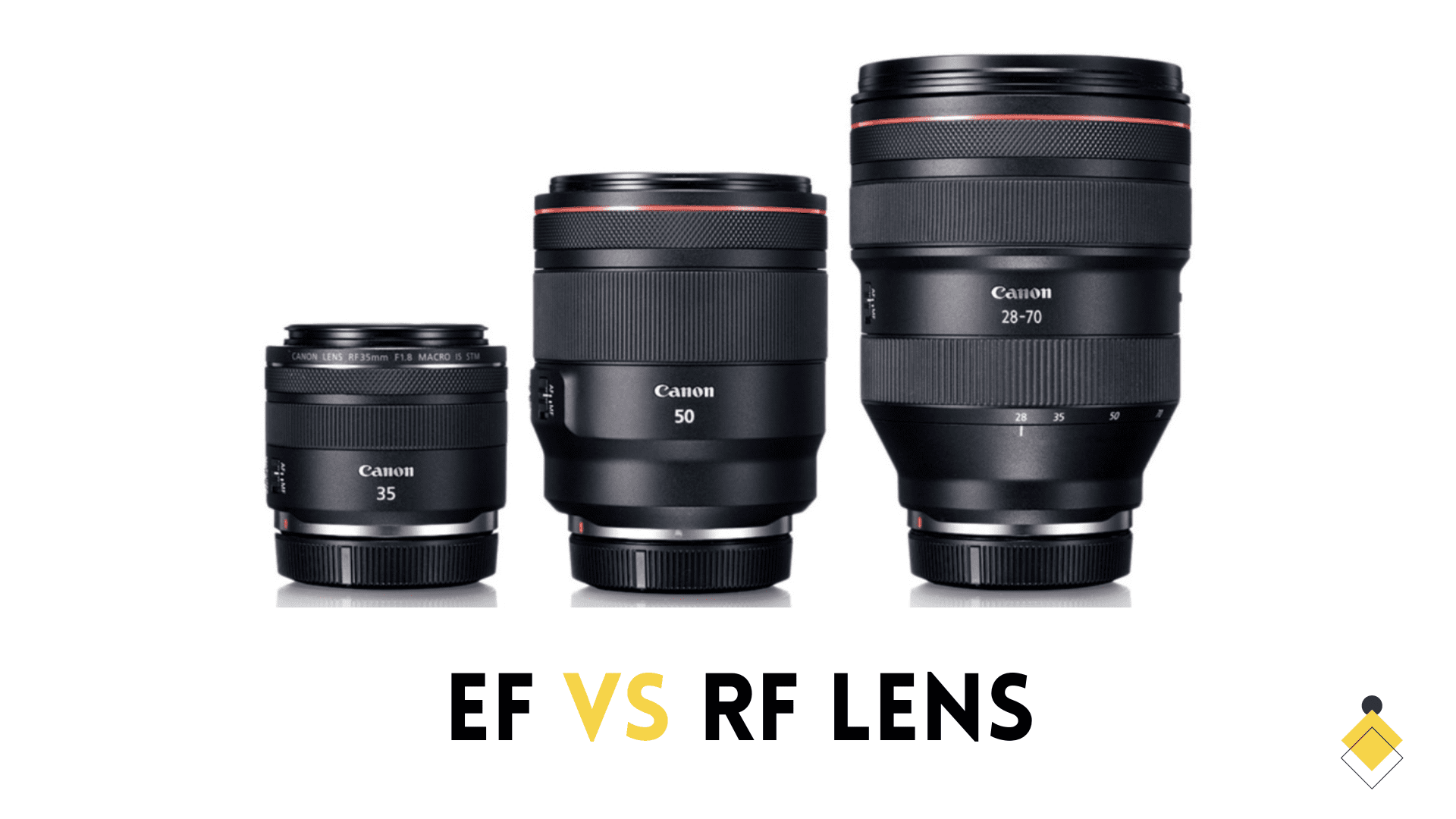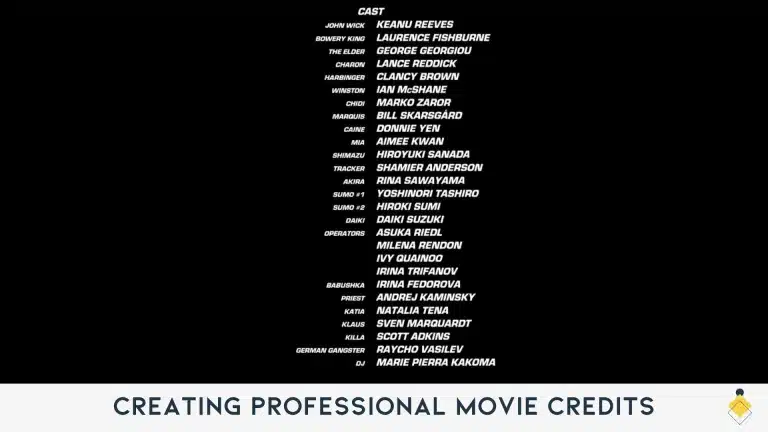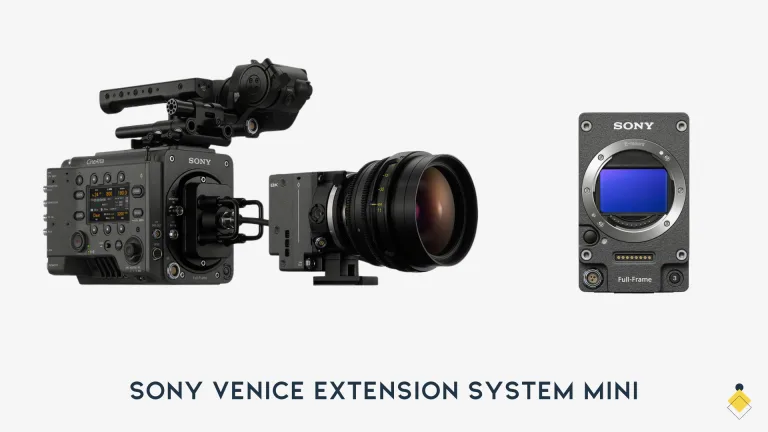Canon shook up the photography world when they announced the EOS R system and new RF lens mount in 2018. This bold move aimed directly at the exploding mirrorless camera market. It left many photographers with a big question: Should they stick with tried-and-true EF lenses or embrace the new RF system?
In this detailed guide, we’ll compare Canon’s EF and RF lenses head-to-head. You’ll learn the pros and cons of both mounts. Whether you shoot with EF glass now or want to jump onto the RF bandwagon, you’ll have the knowledge to choose the best lenses for your needs.
Let’s start with a quick history lesson before jumping into the EF vs RF showdown.
The Rise and Fall of EF Lenses
Canon unveiled the EF lens mount back in 1987 with their EOS 650 SLR camera. The “Electro-Focus” mount replaced Canon’s FD mount and enabled fast autofocus. As the DSLR era dawned, Canon’s EF lenses dominated the digital photography market.
Today EF boasts over 80 lens options covering every focal length and aperture you can imagine. From exotic fisheye lenses to super telephotos over $10,000, EF offers endless creative possibilities. This deep system made EF lenses massively popular. You can find used EF lenses for sale on practically every photo gear trading site.
Yet despite this history of excellence, EF is showing its age in a mirrorless world. The 30-year old mount design was created for DSLR cameras with mirrors and optical viewfinders. But the photography landscape is now shifting to mirrorless. Canon saw the writing on the wall and developed the new RF mount specifically for their EOS R mirrorless system.
RF Mount: Canon’s Mirrorless Innovation
Engineered for mirrorless from the ground up, the RF mount unlocks optical advances not possible with EF. Canon pulled out all the stops to make RF revolutionary:
- A wide 54 mm diameter enables advanced optics and faster lenses.
- The shorter 20 mm flange distance improves wide angle lens design. No mirror means lenses can sit closer to the sensor.
- 12-pin connections enable blazing fast communication between lens and camera.
- The mount itself is crafted from high-precision stainless steel for maximum durability.
By designing RF for mirrorless from scratch, Canon didn’t have to make compromises to accommodate mirrors and optical viewfinders. The result is RF mount lenses that are smaller, lighter, faster, and optically superior to EF lenses in every way.
For photographers who have embraced mirrorless, the RF mount delivers. But what about the legions of photographers with money sunk into EF glass?
Mixing EF and RF
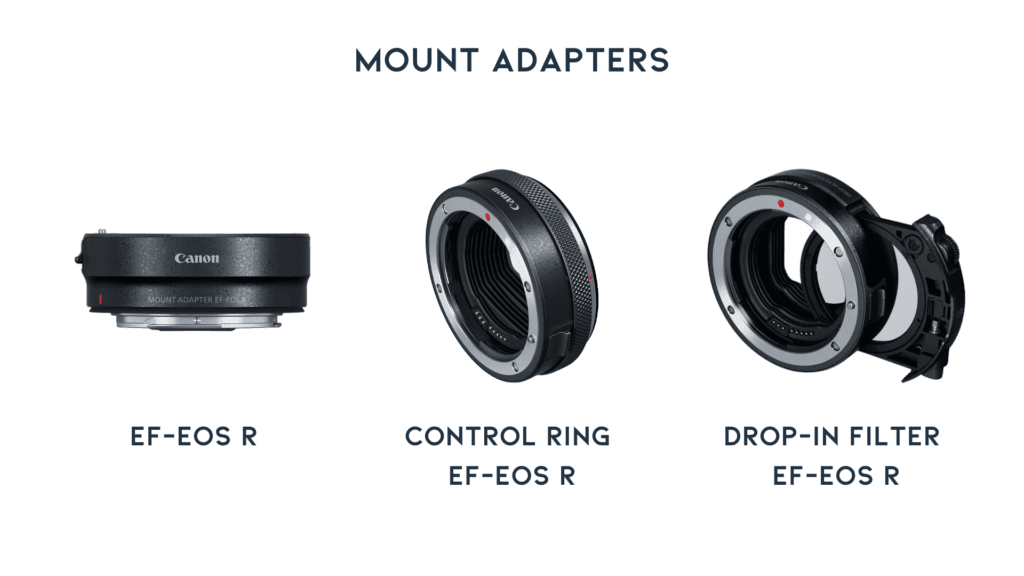
Here’s some brilliant news: Canon designed the EOS R system to seamlessly integrate both EF and RF lenses. You can buy an EOS R camera today and use your existing EF lenses without any loss of functionality through Canon’s EF-EOS R mount adapters. There are 3 adapter options:
- Basic EF-EOS R mount adapter – $99
- Control ring EF-EOS R mount adapter – $199
- Drop-in filter EF-EOS R mount adapter – $299
The basic adapter has no optics and maintains full lens functionality. Autofocus, image stabilization, and auto aperture all work perfectly. Besides some minor performance limitations, EF lenses function like native RF glass on an EOS R camera. This cross-compatibility makes switching to mirrorless easy and cost-effective.
But should you cough up for pricey new RF lenses or stick with tried-and-true EF models? Let’s compare some top pro lenses to see how they stack up.
RF 24-70mm f/2.8L vs EF 24-70mm f/2.8L II
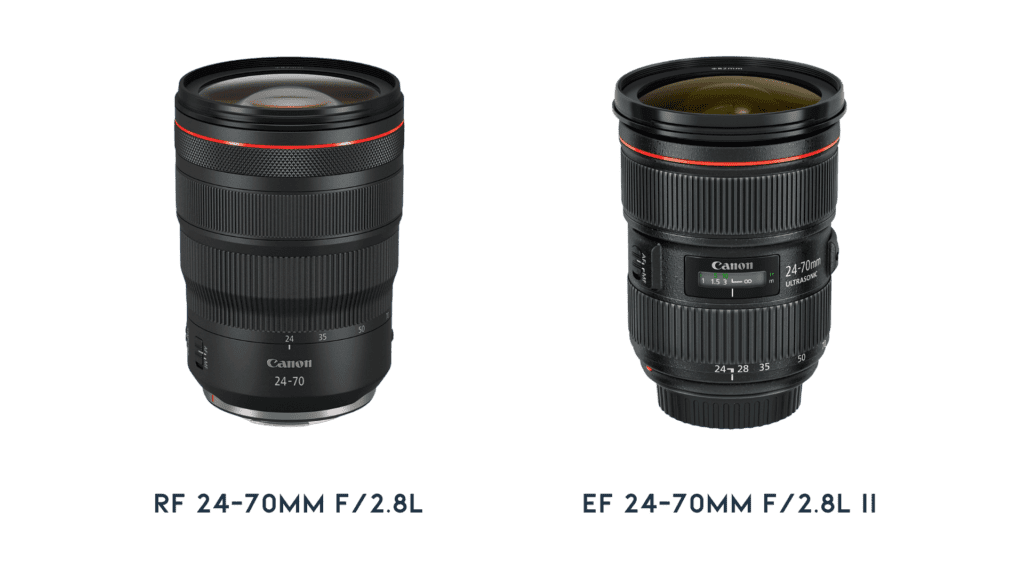
Take Canon’s professional standard zoom lens for example. The venerable EF 24-70mm f/2.8L II has been the workhorse of many pros for over a decade. But the new RF 24-70mm f/2.8L completely rewrites what a pro zoom can deliver:
- 300g lighter weight significantly improves handheld shooting and travel.
- Total optical redesign with BR elements for stunning sharpness.
- Reduction in size by over 30mm for a more compact kit.
- Beautifully even illumination from the wide mount.
- Useful minimum focusing distance of just 0.21m.
Everything about the RF 24-70 outperforms the already excellent EF version. This gives mirrorless shooters better quality in a smaller package.
RF 70-200mm f/2.8L vs EF 70-200mm f/2.8L IS III
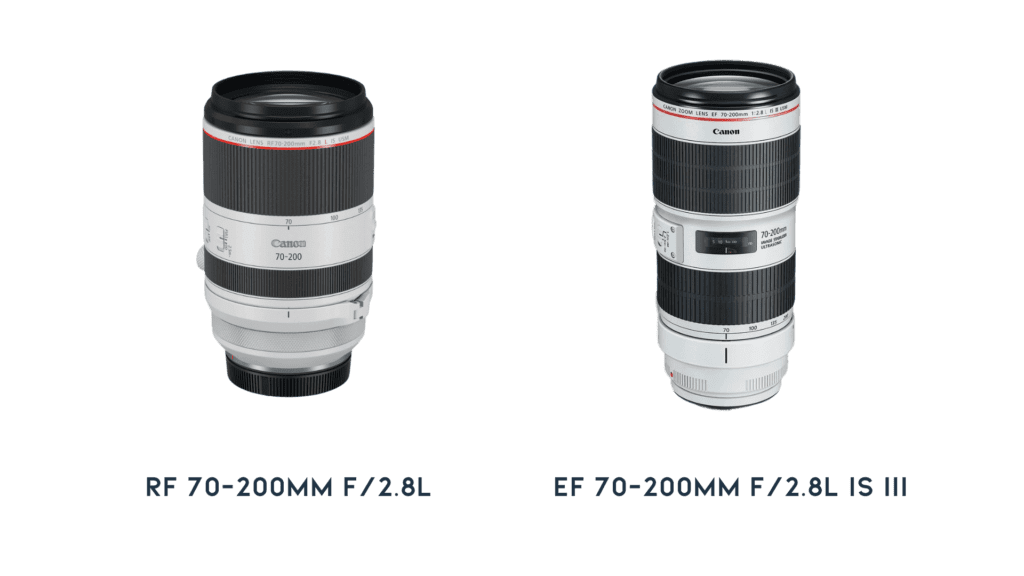
Canon’s top telezoom lens gets a complete overhaul just like the standard zoom. Check out the improvements:
- A whopping 650g lighter for handheld and travel.
- Dual Nano USM focus delivers lightning speed and accuracy.
- 5 stops of stabilization versus 3.5 stops for the EF lens. Huge gain.
- Nearly zero chromatic aberration thanks to optimized BR optics.
The RF 70-200mm F2.8L weighs less than the EF 70-200mm f/4L! Yet it maintains the same f/2.8 constant aperture and weather sealing. This lens demonstrates the true potential of RF.
RF 85mm f/1.2L vs EF 85mm f/1.2L II
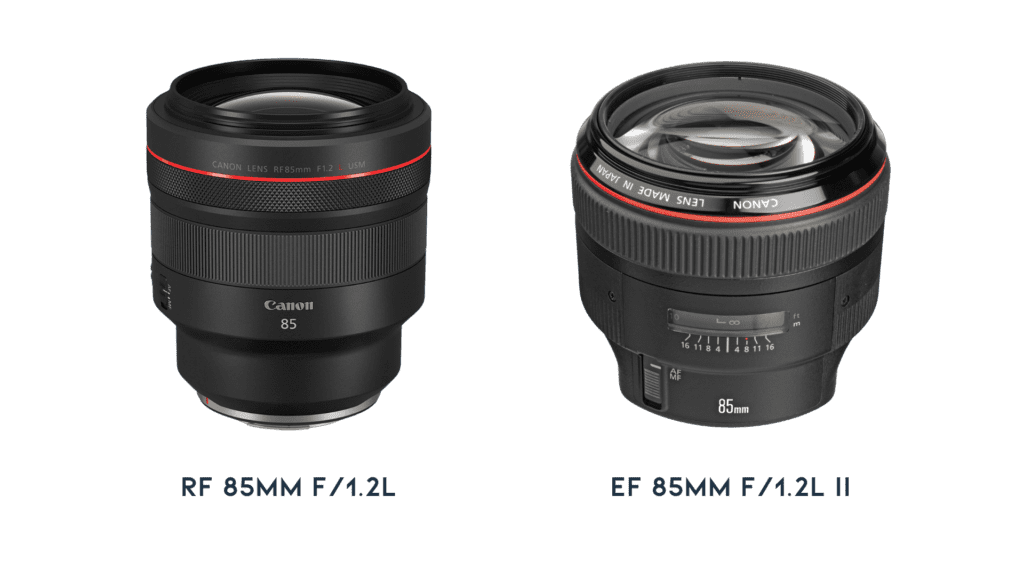
For portrait photographers, Canon’s 85mm f/1.2L glass provides the ultimate dreamy bokeh. Like other RF lenses, the new RF 85mm f/1.2L improves on its EF predecessor:
- Two large aspherical elements and BR optics create razor-sharp images with smooth bokeh.
- Weighs 50g less than the EF version with better balance on camera.
- Weather sealing protects it from the elements.
While both 85mm lenses deliver gorgeous portrait images, the RF version’s optics are improved. Plus it works better on EOS R cameras.
RF 50mm f/1.2L vs EF 50mm f/1.2L
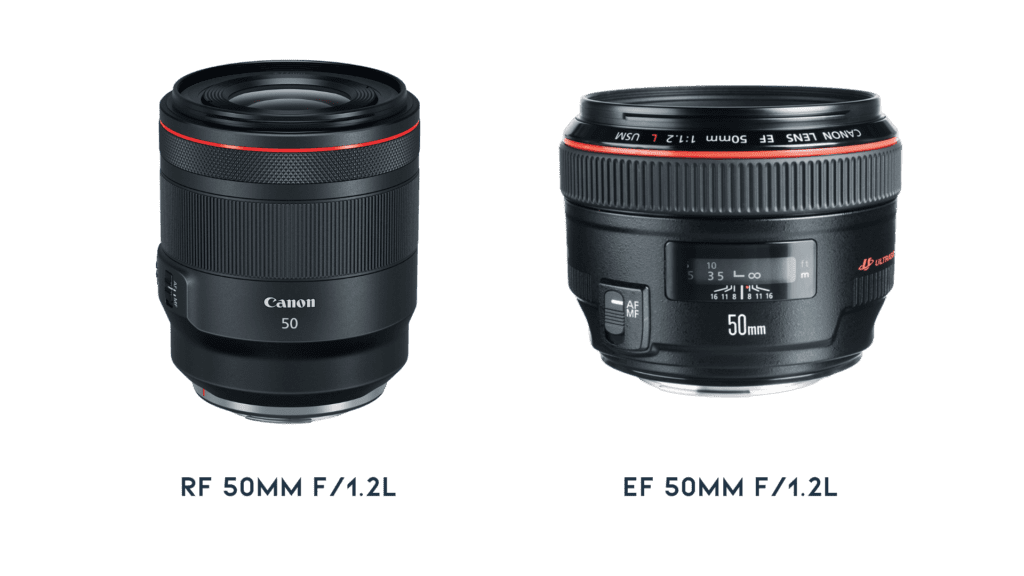
The nifty fifty gets a complete transformation too. Canon overhauled their classic EF 50mm f/1.2L lens for the RF mount:
- New BR optics and 9 aperture blades render images with creamy, dreamy bokeh.
- Dual nano USM focus motors drive twice as fast as the ring USM system.
- Weighs a full 200g less for easy carrying anywhere.
The RF 50mm f/1.2L demonstrates the focusing and optical potential of the new mount. It runs circles around the older EF lens.
The Bottom Line
If you’re a Canon photographer, you’ve got fantastic options right now. EF lenses work flawlessly on modern mirrorless EOS R cameras via an adapter. But for the absolute best performance from your EOS R, new RF lenses are unmatched.
The RF mount unlocks optical and mechanical designs simply not possible on the old EF system. Size, weight, image quality – RF wins every time when pit head-to-head against equivalent EF lenses. There’s no getting around the fact that RF lenses represent the future for Canon.
Yet EF lenses remain perfectly viable too. Used EF lenses offer tremendous value and fill any niche not yet covered by Canon’s RF lineup. The smart strategy is run EF glass on an EOS R body where they make sense, then invest in the key RF lenses you need. Mix and match to maximize performance and value as Canon builds out the RF system.
Either way, photographers win with both EF and RF in Canon’s arsenal. You simply can’t go wrong choosing lenses from either system. Canon has designed EF and RF to work brilliantly together during this time of transition. Mirrorless or DSLR, your images will be amazing.
FAQ – EF vs RF Lens
Yes, you absolutely can. Canon has made two EF-EOS R mount adapters available that allow you to continue to use your EF and EF-S lenses on an EOS R system camera like the EOS R5 or EOS R6. The Mount Adapter EF-EOS R and the Control Ring Mount Adapter EF-EOS R. This makes it simple to transition to the EOS R system while still being able to make use of your existing lens collection.
While both EF and RF lenses have superb image quality, the RF mount lenses, like the RF 28-70mm or RF 24-240mm, are designed to work optimally with EOS R system cameras. They can provide even finer details and generally better optical performance than their EF counterparts, thanks to the closer positioning to the camera sensor.
Yes, the Drop-in Filter Mount Adapter EF-EOS R allows you to use drop-in filters with any EF or EF-S lens. This is a unique feature to the EOS R system and provides a new level of creative control to EF lens users.
There are three total types of EF-EOS R Mount Adapters. The simple Mount Adapter EF-EOS R, the Control Ring Mount Adapter EF-EOS R, which includes a customizable control ring similar to those found on RF lenses, and the Drop-In Filter Mount Adapter EF-EOS R. All of these allow you to use your EF and EF-S lenses with any EOS R system camera.
EF lenses can be used on EOS R system cameras via the appropriate adapter, but RF lenses are designed specifically for use on the EOS R system and cannot be mounted on a traditional EF mount camera.
An RF lens generally offers improved image quality over its EF counterpart, particularly when used on a full frame camera like the Canon EOS R5 or EOS R6. This is possible thanks to the wider and closer mount design of the RF lenses.
No, unfortunately, RF mount lenses are specifically designed to work with the EOS R system and can’t be used with the traditional EF mount cameras. However, with the appropriate adapter, you could use EF and EF-S lenses on an RF camera.
The main difference is in the mount design. While both lens types are made by Canon, EF lenses have been a standard for years, but RF lenses are a newer addition specifically designed for the EOS R system cameras, offering superior optics and performance.
RF lenses have a few unique features not found in EF lenses. For instance, they include a customizable control ring that can adjust various settings like aperture or shutter speed. Furthermore, the RF version generally tends to offer better image quality than EF lenses when used on an EOS R system camera.
The EOS R system handles EF-S lenses much the same way an APS-C sized sensor camera does. When an EF-S lens is attached via the appropriate adapter, the EOS R system automatically crops the image to the size of the smaller APS-C sensor to match the image circle of the lens.

